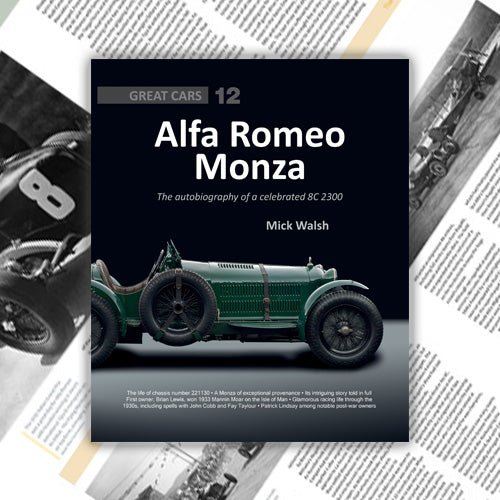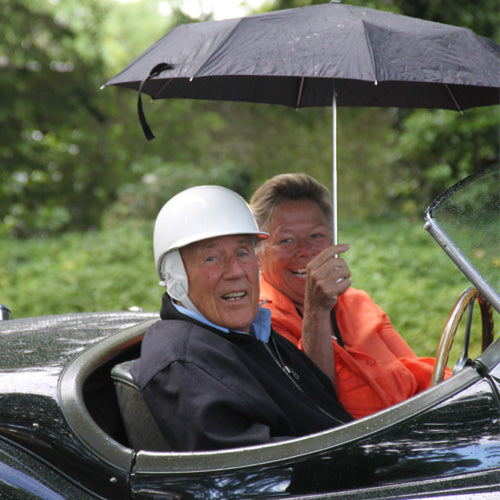
Tazio Nuvolari and the Alfa Romeo Monza: when two legends collided
Tazio Nuvolari, the racing driver acclaimed by Enzo Ferrari as the greatest he had ever seen, said that he expected to die at the wheel of a car. Nuvolari had the disadvantage of being short and skinny in an era of big and heavy racing machines bereft of power steering, but overcame his lack of strength by steering the car on the throttle, a cornering technique which made him one of the earliest exponents - if not perhaps, as Ferrari later claimed, the originator - of the four-wheel-drift. This flamboyant driving style thrilled onlookers but appeared to put Nuvolari at even greater risk of a messy ending - and when he returned to competitive driving in middle-age despite the handicap of lungs ruined by years of inhaling toxic exhaust gases and petrol fumes, strapping a surgical mask to his face and labouring for breath, the suspicion grew that he actively wanted his life to end on the track.
Many were the occasions when Nuvolari’s morbid prophecy looked like coming true. He fell while racing motorbikes, crashed heavily while racing cars, and concluded his only flight in a Blériot monoplane with a fiery impact into a haystack. But on the track, at least, either Nuvolari cheated death or death eluded him: when he was taken from this earth in 1953, aged 60 and partially paralysed from a stroke the previous year, he was lying in his bed. His life as a racing driver had been one of tempting fate and getting away with it, and of the numerous occasions he survived an accident and quickly returned to action, one was doubly remarkable: in the 1931 Mille Miglia, Nuvolari not only injured himself in a crash and raced on, he also gave the Alfa Romeo 8C-2300 its competition debut - so beginning the story of another Italian racing legend.
It might now seem odd, but when two examples of the new 8C-2300 went to the Mille Miglia start-line at Brescia in April 1931 hopes for the cars weren’t high. The Alfa factory team, fearful of embarrassing failure, had taken the precaution of farming-out the entry to Scuderia Ferrari, the privateer outfit set-up by Enzo after he’d left Alfa in November 1929. Nuvolari would drive one of the 8Cs with co-driver Gianbattista Guidotti, with whom he’d won the previous year’s Mille Miglia in the 8C’s predecessor, the 6C 1750. The other 8C was assigned to Luigi Arcangeli and co-driver Felice Bonini. Neither entry was expected to be a match for the new lightweight Mercedes-Benz SSKL, to be driven by Rudolf Carraciola, and aficionados asked how the 2.3-litre Alfa could possibly compare with the new 5-litre Type 50 Bugatti of Achille Varzi.
These doubts will have weighed on the mind of the 8C’s designer, Vittorio Jano, who faced a two-pronged mission with this car: to match the bigger guns from Germany and Britain in competition, particularly at Le Mans, and to provide a series of top-quality touring models for the road. Jano later said the 8C’s conventional channel-section steel-frame chassis was “no masterpiece,” confessing that it was too heavy, and in retrospect his design looks like the last hurrah for the live-axle, leaf-sprung arrangements of the vintage era. But in designing the engine, Jano’s inventive genius was much in evidence: the adoption of supercharging for the straight-eight, a radical departure from mainstream thinking, would show that 2.3-litres could indeed match 5.0.
Initial signs, though, weren’t promising. In secret testing immediately before the ’31 Mille Miglia the 8C was plagued by problems with its Pirelli tyres. In the race’s early stages Carraciola’s Mercedes ran at a storming pace, setting a new record on the run to Bologna, while Nuvolari dropped to fourth after three stops for wheel changes. Between Bologna and Firenze, however, Nuvolari was fastest, despite more stops for tyres, and when the race reached Rome - as far as it would get from the Brescia start-finish point - he was now well enough into his stride to be in the lead and a clear two minutes ahead of Carraciola.
When the surviving runners tackled the perilous twists and turns of the Futa and Raticosa passes, tyres continued to frustrate Nuvolari’s progress, so that the team resorted to mixing brands, but still no one could match his speed. As the route headed further north, through Padova and past Venice, Brescia was now close enough for Nuvolari to entertain thoughts of reaching the finish - but then he misjudged his braking for a T-junction and the Alfa hit a stone wall so hard his head slammed against the tiny windshield, knocking him out. The collision damaged the oil tank and bent the steering, but the car appeared capable of continuing, so Guidotti re-located the woozy Nuvolari to the co-driver’s seat and positioned himself behind the wheel. Guidotti’s pace, however, was a relatively cautious one - and Nuvolari, looking on from his unaccustomed perch in the passenger’s seat with his head wrapped in a bandage, could only contain his frustration for so long. Perhaps clear-headed, perhaps not, he insisted he should return to the wheel.
With these dramas Nuvolari slipped back to ninth place at the finish, a full 98 minutes behind the winner. Scuderia Ferrari’s sister Alfa Romeo 8C had halted way back in Verona after a sizeable accident that injured co-driver Bonini, but for its driver, Arcangeli, worse was to come: in another new Alfa, the Tipo A, at Monza the following month, he would crash into trees and be killed.
As Mercedes and Carraciola celebrated becoming the first non-Italian car and driver to win the Mille Miglia, it was all too easy to overlook the new Alfa Romeo. But Nuvolari had set six fastest section times. That was enough for the Portello factory to push aside Scuderia Ferrari and take Nuvolari and the 8C to the following month’s Targa Florio as an Alfa Corse entry.
Nuvolari and the Alfa won the Targa, defeating the bigger-engined Bugatti of Varzi, and just two weeks later in the Italian Grand Prix at Monza they were victorious again. In recognition of this success, the Alfa Romeo Monza 8C-2300 now had its full name. This model would go on to win Le Mans every year from 1931 to 1934 and many more races besides, building a story which, like that of Tazio Nuvolari, accumulated the status of a legend.
The fascinating origins of this legend, and the detailed story of one particular example of the 8C, can be enjoyed in the 12th title in our Great Cars Series: Alfa Romeo Monza - The autobiography of a celebrated 8C-2300, written by Mick Walsh, the long-serving Editor-in-Chief of Classic & Sports Car magazine. This book tells how Nuvolari was one of a number of extraordinary characters who raced Alfa Romeo Monzas while living lives so colourful they’re worthy of a movie script.
By Phillip Bingham









Leave a comment
This site is protected by hCaptcha and the hCaptcha Privacy Policy and Terms of Service apply.